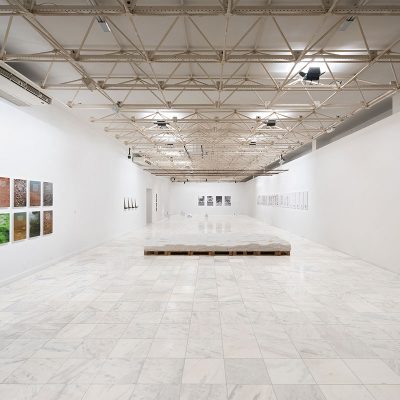
WEST, by Nydia Negromonte
In Latin, while oriens means the place of the sunrise and holds within the idea of becoming visible or originating itself, occidens is the sunset, the fall, the loss. If the east is shining, in the west the night falls, as it is the place of turning off. Complementary as they are, east and west are geographic binaries that confer rhythm to the spacetime of life. That being the case, we learn that the orient orients, and we notice that the west oxidizes the sight in gloaming. The exhibition WEST, by Nydia Negromonte, precisely installs in us this gloaming experience: whatever is not reached by sight during the act of the decline is gathered, studied, measured and put back to work in a new laboratory of sensitivities.
In the exhibition, the tactics of spatial orientation and disorientation can be lived among works that incarnate in their own bodies the unbeatable passage of time. These works choreograph the fragility of the living materials and witness the delirium of the dead materials. Here, east and west are constantly trading places, the end becoming a vector of possibilities and the beginning coming up as promising decadence.
To Nydia, the microscopy of the everyday is precisely the stage for a series of participating observations that generate gestures, actions and processes, which, by their turn, can come to be frozen, through many imagetic strategies, so they can last longer in our memory. The actions of the artist interfere with the objects found in the everyday, mummifying or demummifying them, blowing new life into them or interrupting their natural time. The thread of memory is thus untangled and redrawn.
We can notice that the image is an important part of this newly created laboratory – it is the reagent of fleeting moments. It is an inquisitive dialogue with the image-world that Susan Sontag made reference to, in which reality defines itself from the recording of images, “coveted substitutes for firsthand experience”. According to Sontag, the photographic image, with its imperative of a “death mask” of reality, would form an “interminable dossier” which would compose the collective memories.
In WEST, the photographic memory is a raw material that can be reconstructed, that can be interfered with, that has to be refrozen through a new materic adherence. Matter – a layer of textual inscription, a rice paper or clay drawing – struggles to edit the images, this mnemonic arsenal always so porous to our vast desires. In place of image as a document, we are presented to image as an artifact of memory, a rewritten fable, a piece of plastic editing. We are protagonists instead of hostages of the image-world mentioned by Sontag. The exhibited photographs are an elastic construct that embodies two layers of freezing: one that is previous and optical, and another that is actual, tactile, a new discursive mask, one that transforms instead of representing.
As a second imagetic strategy for the freezing of processes born in the quotidian life, we are also presented to a serialized photographic set that captures instants of death-life in ways that are just as familiar as they are weird. Fruits and legumes pose to the picture in the meantime of their transformation, like hybrid beings in search of a possible design. Those are records obtained in a studio, deliberately set apart from their original everyday world and, with the atmosphere of objectivity of an aseptic laboratory, they negotiate their classificatory singularity in an inexhaustible set.
In its imagetic course, WEST surprises us with the sudden presence of objects that are either derived from images or engage in a dialogue of reciprocities with them. They are conspicuous evidences of bodies that situate themselves phantasmically between the fleeting experience and the sculpture. They are embodiments of the processes of tension between visibility and loss, between the grounds of daily life and atopic eternity, between sunrise and sunset. Mathematical operations engraved in marble, graves dug in a cotton surface, flasks of boiling water modeling shapes and stabbed legumes cast in bronze give subtle concretude to the experience of orientation and disorientation proposed by WEST. And, in this aesthetic horizon, we can finally see the planning of an everyday life that is, at the same time, tragic and prospective, puerile and heroic, intimate and universal.